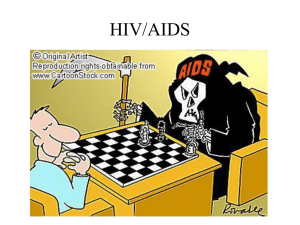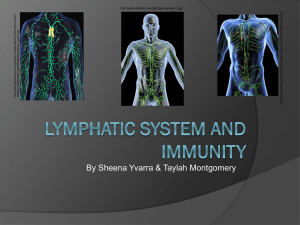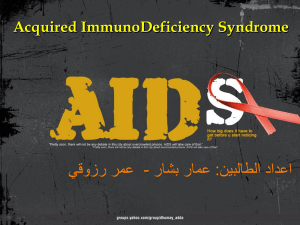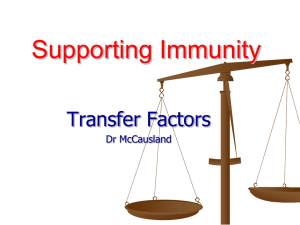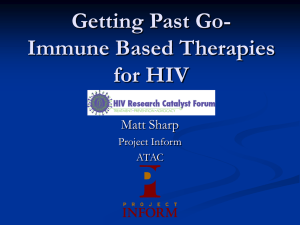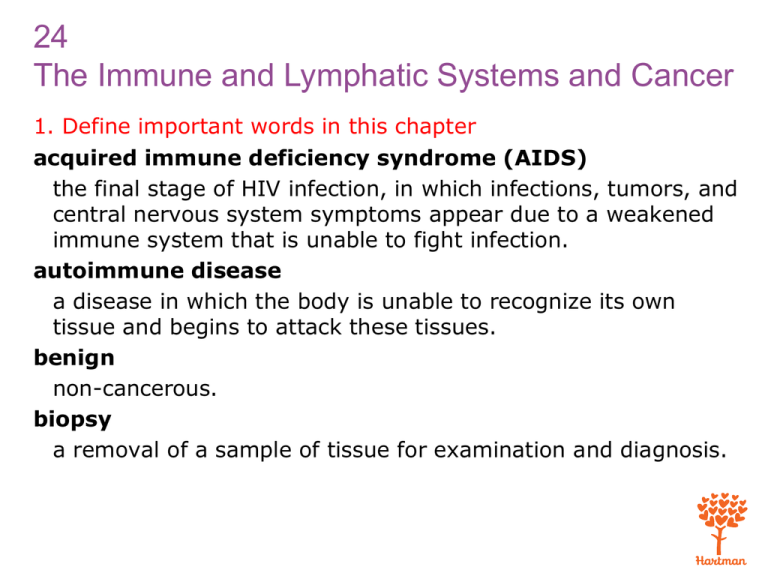
24
The Immune and Lymphatic Systems and Cancer
1. Define important words in this chapter
acquired immune deficiency syndrome (AIDS)
the final stage of HIV infection, in which infections, tumors, and
central nervous system symptoms appear due to a weakened
immune system that is unable to fight infection.
autoimmune disease
a disease in which the body is unable to recognize its own
tissue and begins to attack these tissues.
benign
non-cancerous.
biopsy
a removal of a sample of tissue for examination and diagnosis.
24
The Immune and Lymphatic Systems and Cancer
1. Define important words in this chapter
breakthrough pain
a type of severe pain that happens unexpectedly in people who
have cancer.
cancer
a general term used to describe a disease in which abnormal
cells grow in an uncontrolled way.
homophobia
a fear of homosexuality.
human immunodeficiency virus (HIV)
a virus that attacks the body’s immune system and gradually
disables it; eventually causes AIDS.
24
The Immune and Lymphatic Systems and Cancer
1. Define important words in this chapter
lymph
a clear yellowish fluid that carries disease-fighting cells called
lymphocytes.
malignant
cancerous.
metastasize
to spread from one part of the body to another.
opportunistic infection
an illness caused by microorganisms due to a person’s inability
to fight infection.
24
The Immune and Lymphatic Systems and Cancer
1. Define important words in this chapter
remission
the disappearance of signs and symptoms of cancer or other
diseases; can be temporary or permanent.
tumor
a group of abnormally-growing cells.
24
The Immune and Lymphatic Systems and Cancer
2. Explain the structure and function of the immune and
lymphatic systems
Remember these points about the immune system:
• Protects the body from harmful substances
• Non-specific immunity is present at birth and protects the
body from disease in general.
• Specific immunity is acquired by the body and manufactures
antibodies as a response to an antigen in the body.
• With active immunity, vaccines cause the body to produce
antibodies to protect against a particular disease.
• With passive immunity, a person is given the antibodies
needed to defend against the antigen.
24 The Immune and Lymphatic Systems and Cancer
Transparency 24-1: The Lymphatic System
24
The Immune and Lymphatic Systems and Cancer
2. Explain the structure and function of the immune and
lymphatic systems
Define the following term:
lymph
a clear yellowish fluid that carries disease-fighting cells called
lymphocytes.
24
The Immune and Lymphatic Systems and Cancer
2. Explain the structure and function of the immune and
lymphatic systems
Remember these points about the lymphatic system:
• Removes excess fluids and waste products from the tissues
• Helps the immune system fight infection
• Thymus gland makes T-cells, which attack and destroy
specific types of pathogens.
24
The Immune and Lymphatic Systems and Cancer
2. Explain the structure and function of the immune and
lymphatic systems
Review the functions of the immune and lymphatic systems:
• Protect against the invasion of foreign substances and
pathogens
• Return extra fluid to the circulatory system
24
The Immune and Lymphatic Systems and Cancer
3. Discuss changes in the immune and lymphatic systems due to
aging
Normal changes of aging in the immune and lymphatic systems:
• Immune system weakens, causing increased risk of all types
of infections.
• Antibody response slows.
• T-cells decrease in number.
• Response to vaccine decreases.
24
The Immune and Lymphatic Systems and Cancer
4. Describe a common disorder of the immune system
Define the following terms:
acquired immune deficiency syndrome (AIDS)
the final stage of HIV infection, in which infections, tumors, and
central nervous system symptoms appear due to a weakened
immune system that is unable to fight infection.
human immunodeficiency virus (HIV)
a virus that attacks the body’s immune system and gradually
disables it; eventually causes AIDS.
24
The Immune and Lymphatic Systems and Cancer
4. Describe a common disorder of the immune system
Remember these points about HIV and AIDS:
• HIV attacks the body’s immune system and damages or
destroys cells.
• Cause: HIV virus acquired through blood or body fluids from
an infected person
• AIDS is the final stage of HIV infection.
24
The Immune and Lymphatic Systems and Cancer
4. Describe a common disorder of the immune system
Know the most common methods of transmission of HIV:
• Unprotected or poorly-protected oral, vaginal, or anal sex with
an infected person
• Sharing drug needles or syringes
• Transmission from infected mother to newborn during
pregnancy, birth, or breastfeeding
24
The Immune and Lymphatic Systems and Cancer
4. Describe a common disorder of the immune system
REMEMBER:
In a healthcare setting, infections can be spread through
accidental contact with contaminated body fluids, needles or
other sharp objects, or contaminated supplies or
equipment.
24 The Immune and Lymphatic Systems and Cancer
Handout 24-1: Myths About HIV and AIDS
Myth: If I am HIV positive,
that means I have AIDS.
Fact: HIV positive means that your body was
exposed to the virus. Since your body was
exposed, there is a good chance that you are
infected with the virus. But it does not mean
that you have AIDS. AIDS develops over time.
Myth: HIV is the same as
AIDS.
Fact: HIV is the virus that causes AIDS. AIDS
is a group of symptoms that develop during
the last stage of HIV infection.
Myth: I can get HIV from an infected
person by shaking hands, hugging,
or kissing.
Fact: HIV is not spread through casual
contact. There is a slight possibility that you
could become HIV infected through kissing if
you and the infected person both had open
bleeding sores in your mouths and the
infected person’s blood gets into yours. If you
are really worried about this, do an oral exam
on your partner before kissing.
24 The Immune and Lymphatic Systems and Cancer
Handout 24-1: Myths About HIV and AIDS (cont’d.)
Myth: I can get HIV from telephones.
Fact: The HIV virus can’t live outside of the
body. You cannot become infected through
saliva.
Myth: I can get HIV from door
knobs, tables, chairs, or push
buttons.
Fact: The HIV virus can’t live outside of the
body.
24 The Immune and Lymphatic Systems and Cancer
Handout 24-1: Myths About HIV and AIDS (cont’d.)
Myth: I can get HIV from eating food
that was prepared by an infected
person.
Fact: Once again, HIV dies very quickly
outside the body. Even if the food prep person
cut his finger and then attractively arranged
your food on your plate, you would not
become infected from eating this food. Once
any body fluid is dry, you can be absolutely
sure that the virus is dead. Just about the only
way you could become infected this way is if
the food prep person cuts off a finger, and as
he is bleeding in your food, you are eating it at
that exact moment. This scenario is rather
extreme.
Myth: I can get HIV from
toilets.
Fact: Toilets have been blamed for just about
everything, from getting you pregnant to giving
you sexually-transmitted infections (STIs). The
only way you might possibly become HIV
infected from a toilet seat is to have
unprotected sex while sitting on it!
24 The Immune and Lymphatic Systems and Cancer
Handout 24-1: Myths About HIV and AIDS (cont’d.)
Myth: I can get HIV from mosquitos.
Fact: Although it sounds very possible, you
cannot become HIV infected through
mosquitos, fleas, ticks, or lice. For this to
happen, the HIV would have to survive in the
insect saliva and salivary glands. HIV is a
human virus and cannot survive outside of the
human body. As a result, HIV will not and does
not survive in mosquitos, fleas, ticks, or lice. If
this were a route of transmission, we would all
have been infected a very long time ago.
Myth: I can get HIV from breathing
the same air as an infected person.
Fact: HIV does not spread through the air. You
cannot get HIV by being in the same room
with someone who is infected with the virus.
24
The Immune and Lymphatic Systems and Cancer
4. Describe a common disorder of the immune system
Remember that these common activities do not spread HIV:
• Hugging another person
• Shaking hands
• Sitting on a toilet seat
• Drinking water from a drinking fountain
• Touching a doorknob, telephone, table, or chair
• Using drinking glasses or dishes of infected person
• Being bitten by mosquitoes
24
The Immune and Lymphatic Systems and Cancer
4. Describe a common disorder of the immune system
Know these ways to protect against the spread of HIV/AIDS:
• Practice Standard Precautions on every person in your care.
• Be careful with handling and disposing of sharps.
• Cover any cuts, sores, tears, breaks, or rashes before caring
for residents.
• Never share needles or syringes.
• Do not have unprotected sex.
• Stay in a monogamous relationship.
• Practice abstinence.
• Get tested for HIV and re-tested if necessary.
24
The Immune and Lymphatic Systems and Cancer
4. Describe a common disorder of the immune system
Know the signs and symptoms of HIV infections and AIDS:
• Flu-like symptoms
• Headaches
• Loss of appetite
• Weight loss
• Night sweats
• Shaking, chills
24
The Immune and Lymphatic Systems and Cancer
4. Describe a common disorder of the immune system
Signs and symptoms of HIV infections and AIDS (cont’d.):
• Dry cough
• Shortness of breath
• Swollen lymph nodes
• Sore throat
• Cold sores or fever blisters on lips
• Mouth sores
24
The Immune and Lymphatic Systems and Cancer
4. Describe a common disorder of the immune system
Signs and symptoms of HIV infections and AIDS (cont’d.):
• White patches on the mouth or tongue
• Cauliflower-like warts on the skin or in mouth
• Bleeding, inflamed gums
• Yeast infections
• Skin rashes or sores
• Bruising that does not go away
24
The Immune and Lymphatic Systems and Cancer
4. Describe a common disorder of the immune system
Signs and symptoms of HIV infections and AIDS (cont’d.):
• Dry skin
• Nausea and vomiting
• Blurred vision
• Memory loss
24
The Immune and Lymphatic Systems and Cancer
4. Describe a common disorder of the immune system
Define the following term:
opportunistic infection
an illness caused by microorganisms due to a person’s inability
to fight infection.
24
The Immune and Lymphatic Systems and Cancer
4. Describe a common disorder of the immune system
REMEMBER:
People with weakened immune systems due to HIV/AIDS may
get opportunistic infections, or diseases that a healthy person
would be able to fight off. Lack of treatment for HIV/AIDS
increases the risk of serious complications and death from the
disease.
24
The Immune and Lymphatic Systems and Cancer
4. Describe a common disorder of the immune system
Define the following term:
autoimmune disease
a disease in which the body is unable to recognize its own
tissue and begins to attack these tissues.
24
The Immune and Lymphatic Systems and Cancer
4. Describe a common disorder of the immune system
Know these points about autoimmune diseases:
• The body is unable to recognize its own tissue and attacks it.
• Examples: systemic lupus erythematosis and rheumatoid
arthritis
• Cause: unknown, but may be genetic links, microorganisms or
medications that act as triggers
• Signs and symptoms: fever, fatigue, dizziness
• Treatment: hormone supplements, medications, blood
transfusions, insulin
24
The Immune and Lymphatic Systems and Cancer
5. Discuss infection prevention guidelines for a resident with
HIV/AIDS
REMEMBER:
It is very important to follow Standard Precautions with every
single resident in your care. If you do this, there should be no
difference in the care given to a resident with HIV/AIDS and care
given to any other resident.
24
The Immune and Lymphatic Systems and Cancer
5. Discuss infection prevention guidelines for a resident with
HIV/AIDS
Know these infection prevention guidelines for HIV/AIDS:
• Follow proper infection prevention procedures and Standard
Precautions with all residents.
• Wear appropriate PPE.
• Cover all broken skin with appropriate bandages before giving
care.
• Wash hands and other areas of body immediately after
contact with blood or body fluids.
24
The Immune and Lymphatic Systems and Cancer
5. Discuss infection prevention guidelines for a resident with
HIV/AIDS
Infection prevention guidelines for HIV/AIDS (cont’d.):
• Handle and dispose of sharps carefully.
• Remind residents and visitors to wash their hands often.
• Do not share residents’ personal items.
• Properly disinfect surfaces.
24
The Immune and Lymphatic Systems and Cancer
6. Discuss care guidelines for a resident with HIV/AIDS
Define the following term:
homophobia
a fear of homosexuality.
24
The Immune and Lymphatic Systems and Cancer
6. Discuss care guidelines for a resident with HIV/AIDS
Remember these care guidelines for HIV/AIDS:
• Wash hands often and help residents wash hands.
• Disinfect surfaces often.
• Protect resident from people having known contagious
diseases.
• Change linen whenever it is soiled.
• Observe for skin breakdown.
• Change positions every two hours, or as directed
24
The Immune and Lymphatic Systems and Cancer
6. Discuss care guidelines for a resident with HIV/AIDS
Care guidelines for HIV/AIDS (cont’d.):
• Give back rubs for comfort.
• Monitor vital signs often.
• Allow rest and recognize limitations.
• Ambulate carefully.
• Allow time for ADLs.
• Perform ROM exercises as ordered.
24
The Immune and Lymphatic Systems and Cancer
6. Discuss care guidelines for a resident with HIV/AIDS
Care guidelines for HIV/AIDS (cont’d.):
• Give quality mouth care frequently.
• Use soft toothbrushes or swabs for oral care.
• Report if resident is not eating or not enjoying food.
• Encourage residents to follow their special diets.
• Encourage fluids.
• Give small meals throughout day or BRAT, BRATY, or BRATT
diet for nausea and diarrhea.
24
The Immune and Lymphatic Systems and Cancer
6. Discuss care guidelines for a resident with HIV/AIDS
Care guidelines for HIV/AIDS (cont’d.):
• Carefully measure weight and I&O.
• Offer a trip to the bathroom or bedpan as often as needed.
• Encourage independence.
• Give emotional support. Some people avoid a person with
AIDS due to homophobia.
• Be aware of other support systems.
24
The Immune and Lymphatic Systems and Cancer
6. Discuss care guidelines for a resident with HIV/AIDS
Report any of these symptoms of HIV/AIDS to the nurse:
• Loss of appetite, vomiting, or diarrhea
• Weight loss
• Reduced intake of fluids
• Mouth sores or discomfort
• Dysphagia
24
The Immune and Lymphatic Systems and Cancer
6. Discuss care guidelines for a resident with HIV/AIDS
Report any of these symptoms of HIV/AIDS (cont’d.):
• Bleeding from anywhere on the body
• Bruising of skin
• Pressure ulcers
• Cracks, breaks, rashes, lumps, or sores on the skin
• Blood in stool
24
The Immune and Lymphatic Systems and Cancer
6. Discuss care guidelines for a resident with HIV/AIDS
Report any of these symptoms of HIV/AIDS (cont’d.):
• Changes in vital signs
• Nervousness, withdrawal, severe mood swings, depression
• Behavior that puts resident or others at risk, suicidal thoughts
or comments
24
The Immune and Lymphatic Systems and Cancer
7. Describe cancer
Define the following terms:
cancer
a general term used to describe a disease in which abnormal
cells grow in an uncontrolled way.
tumor
a group of abnormally-growing cells.
benign
non-cancerous.
malignant
cancerous.
metastasize
to spread from one part of the body to another.
24
The Immune and Lymphatic Systems and Cancer
7. Describe cancer
Cancer usually occurs in the form of a tumor that grows on or
within the human body.
Tumors are either benign (non-cancerous) or malignant
(cancerous).
Cancer can act in different ways. It can metastasize, or spread,
to other areas of the body.
24
The Immune and Lymphatic Systems and Cancer
7. Describe cancer
Know the risk factors for cancer:
• Age
• Race
• Gender
• Family history
• Tobacco use
24
The Immune and Lymphatic Systems and Cancer
7. Describe cancer
Risk factors for cancer (cont’d.):
• Alcohol use
• Poor diet/obesity
• Lack of exercise
• Chemicals and food additives
• Radiation
• Sun exposure
24
The Immune and Lymphatic Systems and Cancer
7. Describe cancer
Understand the signs of cancer, as defined by the American
Cancer Society:
• Fever
• Fatigue
• Unexplained weight loss
• Pain
• Skin changes
24
The Immune and Lymphatic Systems and Cancer
7. Describe cancer
Signs of cancer (cont’d.):
• New mole or change in appearance of existing mole or wart
• Change in bowel/bladder function
• Sore that does not heal
• Unusual bleeding/discharge
• Any thickening in breast, scrotum, or other areas
24
The Immune and Lymphatic Systems and Cancer
7. Describe cancer
Signs of cancer (cont’d.):
• Indigestion, difficulty swallowing
• Nagging cough or hoarseness
24
The Immune and Lymphatic Systems and Cancer
7. Describe cancer
Define the following term:
biopsy
a removal of a sample of tissue for examination and diagnosis.
24
The Immune and Lymphatic Systems and Cancer
7. Describe cancer
A diagnosis of cancer is made after various tests, such as a
biopsy, have been performed. A biopsy is the removal of a
sample of tissue for examination and diagnosis.
After the diagnosis of cancer is made, the treatment plan is
developed. Treatment is based on whether or not the cancer has
spread to other parts of the body, or metastasized.
24
The Immune and Lymphatic Systems and Cancer
7. Describe cancer
There are various treatments for cancer, and they are often used
in combination:
• Surgery
• Radiation therapy
• Chemotherapy
• Hormone therapy
• Immunotherapy
24
The Immune and Lymphatic Systems and Cancer
8. Discuss care guidelines for a resident with cancer
Remember these skin care guidelines for residents with cancer:
• Observe skin to prevent pressure ulcers.
• Change position every two hours or as directed.
• Follow special skin care orders exactly.
• Use special mattresses or pads in beds and chairs to reduce
risk of pressure ulcers.
24
The Immune and Lymphatic Systems and Cancer
8. Discuss care guidelines for a resident with cancer
Skin care guidelines for residents with cancer (cont’d.):
• Keep skin clean and dry.
• Apply lotion to dry skin.
• Do not use lotion on areas having radiation therapy.
• Do not remove any markings used with radiation therapy.
• Report signs of infection.
24
The Immune and Lymphatic Systems and Cancer
8. Discuss care guidelines for a resident with cancer
Know these guidelines for supporting good self-image in
residents with cancer:
• Help residents stay clean and well-groomed.
• Offer wigs, scarves, or hats for hair loss.
• Assist with application of makeup, as requested.
24
The Immune and Lymphatic Systems and Cancer
8. Discuss care guidelines for a resident with cancer
Use these oral care guidelines for residents with cancer:
• Give oral care often.
• Be gentle.
• Use soft brushes or special swabs.
• Use mild mouth rinses to reduce bad taste from medication or
vomiting.
24
The Immune and Lymphatic Systems and Cancer
8. Discuss care guidelines for a resident with cancer
REMEMBER:
Cancer can cause severe pain. It can affect the ability to sleep,
eat, and move about. Medications and other measures are used
to treat pain. Observe and report signs of pain in residents with
cancer.
24
The Immune and Lymphatic Systems and Cancer
8. Discuss care guidelines for a resident with cancer
Define the following term:
breakthrough pain
a type of severe pain that happens unexpectedly in people who
have cancer.
24
The Immune and Lymphatic Systems and Cancer
8. Discuss care guidelines for a resident with cancer
Know these care guidelines for pain in residents with cancer:
• Be alert for signs of pain and report immediately.
• Provide comfort measures, such as back rubs and
repositioning. Play soft music, read, or talk quietly with
residents.
• Notify nurse of side effects of pain medication.
• Report irritation around transdermal patches or resident
having more than one patch on the body.
• Observe for redness, swelling, or warmth around the insertion
site of PCA pump.
• Report signs of breakthrough pain.
24
The Immune and Lymphatic Systems and Cancer
8. Discuss care guidelines for a resident with cancer
Remember these vital signs guidelines for residents with cancer:
• Monitor all vital signs, especially temperature.
• Report changes in vital signs to nurse.
24
The Immune and Lymphatic Systems and Cancer
8. Discuss care guidelines for a resident with cancer
Know these guidelines for mobility for residents with cancer:
• Allow plenty of time for rest.
• Recognize limitations.
• Assist with ambulation.
24
The Immune and Lymphatic Systems and Cancer
8. Discuss care guidelines for a resident with cancer
Remember these nutrition guidelines for residents with cancer:
• Provide small, frequent meals to reduce nausea and prevent
weight loss.
• Serve favorite foods and nutritious snacks.
• Provide food when hunger occurs.
• Try cool or cold foods.
24
The Immune and Lymphatic Systems and Cancer
8. Discuss care guidelines for a resident with cancer
Nutrition guidelines for residents with cancer (cont’d.):
• Cut foods into small pieces.
• Use plastic utensils.
• Weigh residents as ordered and report loss or gain.
• Encourage fluids.
• Monitor I&O and report changes.
24
The Immune and Lymphatic Systems and Cancer
8. Discuss care guidelines for a resident with cancer
Know these guidelines for bladder and bowel changes for
residents with cancer:
• Assist residents with toileting often.
• Give catheter care as needed.
• Carefully measure output.
• Test stool for occult blood as ordered.
24
The Immune and Lymphatic Systems and Cancer
8. Discuss care guidelines for a resident with cancer
Know these guidelines for understanding the mental status and
meeting the emotional needs of residents with cancer:
• Be sensitive to residents’ wishes.
• Listen if residents want to express feelings.
• Spend as much time with residents as possible.
• Encourage activities.
• Ask social worker about support groups.
24
The Immune and Lymphatic Systems and Cancer
8. Discuss care guidelines for a resident with cancer
Guidelines for understanding the mental status and meeting the
emotional needs of residents with cancer (cont’d.):
• Do not use clichés.
• Provide support during painful episodes and difficult times.
• Remind residents that there can be good days ahead.
• Observe and report signs of depression or comments about
suicide.
24
The Immune and Lymphatic Systems and Cancer
8. Discuss care guidelines for a resident with cancer
Know the symptoms to observe and report:
• Pain or increased pain
• Changes in vital signs
• Signs of new bumps or lumps or changes in skin
• Rashes, cracks, sores, breaks, or reddened areas on the skin
• Odors
24
The Immune and Lymphatic Systems and Cancer
8. Discuss care guidelines for a resident with cancer
Symptoms to observe and report (cont’d.):
• Burns or skin irritation
• Bruising of the skin
• Difficulty with ambulation
• Fainting
• Increased fatigue or weakness
24
The Immune and Lymphatic Systems and Cancer
8. Discuss care guidelines for a resident with cancer
Symptoms to observe and report (cont’d.):
• Chest pain or tightness
• Shortness of breath
• Appetite changes or weight loss
• Difficulty chewing or swallowing
• Dry, sore mouth and mouth or lip sores
24
The Immune and Lymphatic Systems and Cancer
8. Discuss care guidelines for a resident with cancer
Symptoms to observe and report (cont’d.):
• Inflammation or irritation of the mucous membranes in the
mouth
• Bleeding from inside the mouth
• Nausea or vomiting
• Flatus, diarrhea, or constipation
• Blood in the stool
24
The Immune and Lymphatic Systems and Cancer
8. Discuss care guidelines for a resident with cancer
Symptoms to observe and report (cont’d.):
• Change in output
• Any change in urine or blood in urine
• Urinary tract infection
• Change in mental status or confusion
• Anxiety, fear, or angry feelings
• Signs of depression
24
The Immune and Lymphatic Systems and Cancer
Exam
Multiple Choice. Choose the correct answer.
1. Immunity that protects the body from disease in general and is the first line of
defense against invading bacteria or organisms is called:
(A) Specific immunity
(B) Nonspecific immunity
(C) Active immunity
(D) Passive immunity
2. With ______ immunity, a person is given the antibodies needed to defend
against an antigen.
(A) Specific
(B) Nonspecific
(C) Active
(D) Passive
24
The Immune and Lymphatic Systems and Cancer
Exam (cont’d.)
3. Which of the following is a function of the immune system?
(A) Maintains blood sugar levels
(B) Regulates the production of hormones
(C) Protects against the invasion of foreign substances and pathogens
(D) Regulates body temperature
4. Normal age-related changes for the immune and lymphatic systems include:
(A) Immune system weakens
(B) Antibody response speeds up
(C) T-cells increase in number
(D) Response to vaccines increases
24
The Immune and Lymphatic Systems and Cancer
Exam (cont’d.)
5. HIV can be transmitted:
(A) To a nursing assistant who touches an infected resident’s telephone
(B) To anyone who uses the same toilet as an infected person
(C) To people who hug an infected person when that person has a fever
(D) To a fetus by an infected mother
6. Which of the following is a sign or symptom of the beginning stages of HIV
infection?
(A) Poor circulation
(B) Damage to the eyes
(C) Open sores on the penis
(D) Flu-like symptoms
24
The Immune and Lymphatic Systems and Cancer
Exam (cont’d.)
7. Which of the following statements is true of HIV and AIDS?
(A) AIDS can be cured.
(B) Having unprotected sex puts a person at a high risk for HIV/AIDS.
(C) Standard Precautions do not need to be practiced on a person who has AIDS.
(D) A person with HIV can be fired because of the disease.
8. A resident with AIDS who has an infection of the mouth may need to eat food
that is:
(A) Spicy
(B) Soft or pureed
(C) Hot
(D) Acidic
24
The Immune and Lymphatic Systems and Cancer
Exam (cont’d.)
9. A resident with AIDS who has nausea and is vomiting should:
(A) Eat small, frequent meals
(B) Eat quickly
(C) Not drink liquids
(D) Not eat at all
10. The “BRAT” diet is helpful for:
(A) Diarrhea
(B) Weight gain
(C) Weight loss
(D) Numbness and tingling
24
The Immune and Lymphatic Systems and Cancer
Exam (cont’d.)
11. A tumor that is cancerous is called a(n) ______ tumor.
(A) Opportunistic
(B) Benign
(C) Malignant
(D) Metastasized
12. ______ is a method of treatment for cancer that uses high-energy waves to
attempt to destroy cancer cells in a specific area.
(A) Radiation therapy
(B) Chemotherapy
(C) Hormone therapy
(D) Immunotherapy
24
The Immune and Lymphatic Systems and Cancer
Exam (cont’d.)
13. The key treatment for malignant tumors of the skin, breast, and colon is:
(A) Surgery
(B) Chemotherapy
(C) Radiation
(D) Diet and exercise
14. When is a resident with cancer most likely to suffer from nausea, vomiting,
diarrhea, hair loss, and decreased resistance to infection?
(A) Right after surgery
(B) Just before the cancer is diagnosed
(C) When the resident is near death
(D) When undergoing chemotherapy
24
The Immune and Lymphatic Systems and Cancer
Exam (cont’d.)
15. Which of the following is a good idea for communicating with a resident who
has cancer?
(A) Insist that the resident tell you what he or she is going through.
(B) Listen to the resident if he or she feels like talking.
(C) If the resident is worried, tell him or her, “It’ll all be fine.”
(D) Tell the resident your grandmother beat cancer and you’re sure the resident
will, too.
16. Which of the following is helpful when providing skin care for a resident with
cancer?
(A) Change positions at least every four hours.
(B) Remove markings for radiation therapy each time you bathe the resident.
(C) Avoid applying lotion to areas receiving radiation therapy.
(D) Keeping the skin wet helps with the side effects of radiation therapy.



